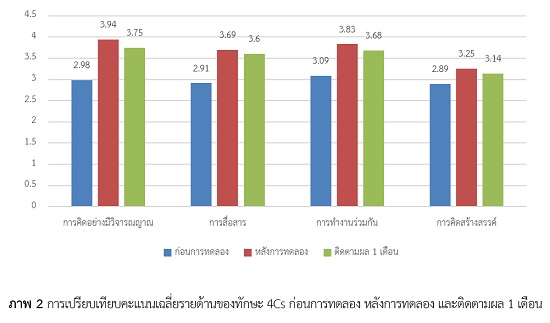THE DEVELOPMENT OF GUIDANCE ACTIVITIES BASED ON THE DESIGN THINKING APPROACH TO ENHANCE LEARNING AND INNOVATION SKILLS (4Cs) OF PRIMARY SCHOOL STUDENTS
DOI:
https://doi.org/10.14456/nrru-rdi.2022.28Keywords:
Guidance activities, Design thinking approach, 4Cs skills, Primary school studentsAbstract
The two objectives of this research were: 1) To develop guidance activities based on the design thinking approach to enhancing 4Cs skills for primary school students; and 2) to study the result of using the guidance activities based on the design thinking approach to enhance 4Cs skills for primary school students in a pre-posttest research design, with a follow-up test. The procedure was divided into 2 steps: 1) The development of the guidance activities by 10 experts in guidance, including experts for interviewing, brainstorming and evaluating the appropriateness of the guidance activities; and 2) The experiment of the guidance activities consisted of 33 students in grades 4-6 of Ban Mae Soon Noi School who were selected through purposive sampling. The three research instruments consisted of: 1) A 4Cs skills questionnaire; 2) A package of guidance activities; and 3) A satisfaction questionnaire. The reliability coefficient of the total scale was very high at .90. The data were analyzed using mean, standard deviation, and one-way repeated measurement MANOVA. The main research findings were: 1) The guidance activities based on the design thinking approach to enhance 4Cs skills for primary school students were at the most appropriate level; 2) Students who participated in the guidance activities had mean scores that had a statistically significant difference between the pre-test and post-test scores of 4Cs skills and no differences between the follow-up and post-test scores of 4Cs skills; and 3) Students’ satisfaction with the guidance activities package was at a very high level.
References
Auld, S. (2021). Critical thinking: an essential skill for every student. Retrieved May 10, 2021, from https://www.acc.edu.au/blog/critical-thinking-essential-skill/
Brown, T. (2009). Change by design: How design thinking transforms organizations and Inspires innovation. New York : Harper Collins Publishers.
Chanprasert, S. (2014). Active learning: Learning management in the 21st century. Institute for the Promotion of Teaching Science and Technology Magazine, 42(128), 3-6. (In Thai)
D.school. (2019). Design thinking boot camp. Retrieved September 26, 2019, from https://dschool. stanford.edu/executive-education/dbootcamp
Ellis, M., Kisling, E., & Hackworth, R. (2014). Teaching soft skills employers need. Community College Journal of Research & Practice, 38, 433-453.
Hasso plattner institute. (2019). Design thinking. Retrieved September 26, 2019, from https:// hpi.de/school-of-design-thinking/design-thinking.html
Johnson, B. (2019). 4 Ways to develop creativity in students. Retrieved May 10, 2021, from https://www. edutopia.org/article/4-ways-develop-creativity-students
Kanga, M. B. (2017). Effectiveness of guidance and counselling service in enhancing student’ adjustment to school academic environment in public boarding secondary schools in Kenya. International Journal for Innovation Education and Research, 5(7), 75-87.
Lally, M., & Valentine-French, S. (2019). Lifespan development: A psychological perspective (2nd ed.). California, USA : College of Lake County Faculty.
Loveless, A. M. (2002), Literature review in creativity, new technologies and learning. Bristol : National endowment for science technology and the arts future lab.
Martin, R. A. (2012). Social and emotional learning research: intervention studies for supporting adolescents in turkey. Procedia-Social and Behavioral Sciences, 69, 1469-1476.
Meesuk, P. (2016). Educational research. Bangkok : Triple Education.
Ministry of education. (2009). Basic education core curriculum 2008. Bangkok : Agricultural Cooperative Community of Thailand. (In Thai)
Norman, G. (2010). Likert scales, levels of measurement and the “laws” of statistics. Advances in Health Science Education, 15, 625-632.
Office of the national economic and social development council. (2018). The 20-year national strategy (2018-2037). Retrieved September 20, 2020, from https://bit.ly/35l6O3e. (In Thai)
Partnership for 21st Century Skills. (2019). Framework for 21st century learning. Retrieved October 2, 2019, from http://www.battelleforkids.org/networks/p21/frameworks-resources
Penrattanahiran, R. (2021). General psychology (2nd ed). Chiang Mai : Sor.Information Technology Company Limited. (In Thai)
Polit, D. F., & Beck, C. T. (2009). Nursing research: Generating and assign evidence for nursing practice (7th ed.). Philadelphia : Lippincott.
Sheridan, M., Howard, J., & Alderson, D. (2011). Play in early childhood: From birth to six years (3rd ed.). New York, New York : Taylor & Francis.
Sitdhisamarn, S. (2020). Creativity of missing Thai children. Retrieved May 13, 2021, from https://bit.ly/2Tx6eN9 (In Thai)
Teneri, P. O. (2012). Roles of parents in enhancing children’s creative thinking skill. International Journal of Human Sciences, 9(2), 91-108.
The institute for the promotion of teaching science and technology. (2013). Preliminary data analysis report: PISA 2012 project. Bangkok : Arun Printing.
Wahl, H., Kaufmann, C., Eckkrammer, F., Mense, A., Gollner, H., Himmler, C., Rogner, W., Baierl, T., & Slobodian, R. (2012). Soft skills in practice and in education: An evaluation. American Journal of Business Education, 5, 225-232.
Wongkitrungruang, W., & Jittaruk, A. (2013). Skills of the future for 21st century education: 21st century skills: Rethinking how students learn. Bangkok : Open World. (In Thai)
World economic forum. (2018). The future of jobs report 2018. Retrieved September 3, 2019, from https://www.weforum.org/reports/the-future-of-jobs-report-2018

Downloads
Published
How to Cite
Issue
Section
License

This work is licensed under a Creative Commons Attribution-NonCommercial-NoDerivatives 4.0 International License.




